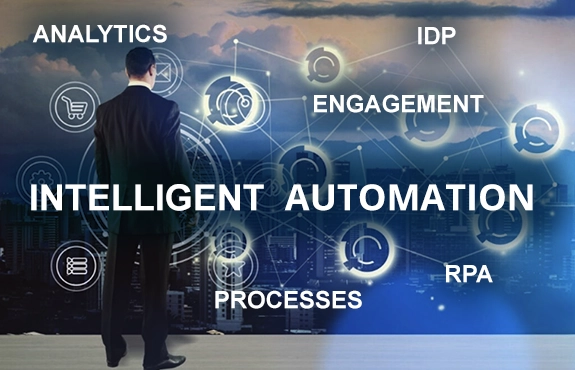What To Do When Tungsten Automation's Transformation’s Table Locator Does Not Work
The Tungsten Automation Transformation’s Table Locator is a powerful tool for extracting data presented on a document in table form. Simply align the...
4 min read
 Randy Dufault, Olivia King & Chris Lundbohm
:
May 23, 2024
Randy Dufault, Olivia King & Chris Lundbohm
:
May 23, 2024

Intelligent Automation (IA) systems are software that enable business process automation and accelerate digital transformation. In this blog, we'll explore the 5 key systems that work together in an IA platform, from managing documents to analyzing workflows. Discover how IA can streamline tasks, boost accuracy, and empower your business to thrive. Let's get started!
1. Process Orchestration connects systems and people together in a concise, predictable, manageable, and measurable way.
2. Intelligent Document Processing (IDP) converts the unstructured content contained in business communications into the information a process requires.
3. Robotic Process Automation (RPA) moves non-cognitive, repetitive tasks away from users and into the machine.
4. User Engagement communicates with humans, using a process in several diverse ways.
5. Analytics use data collected across processes to help understand historical business performance and to help predict future needs and budgets.
When these systems are integrated together in an IA platform, they create a powerful and configurable mechanism for transforming a business process. Let's take a deeper look:
Process orchestration ties systems and humans together in ways that drive efficiency, accuracy, and accountability. A customer service event begins with a notification from a customer, which may be a phone call, email, or a physical letter.
Once the event has started, the first step is to define the relationship with the customer. Using data like a phone number or email address, the process queries line-of-business software systems to gather information like the customer's name and purchase history.
The customer service agent now has the information needed about the customer and can more efficiently help them solve their issue. Process configuration can also take care of process needs like de-escalation to a supervisor, and steps to handle other exceptional situations.
Orchestration logs save everything that happens within a customer service event. Businesses must know how they are doing, and orchestration logs deliver a look into processes' real-time state. The logs streamline the process of servicing a customer base. Businesses can also examine logs to understand the overall performance of the staff operating the customer service system.
To put it simply, process orchestration connects systems and humans together in smart ways and makes businesses better.
Global business runs on the exchange of documents. Documents such as PDFs, emails, web portals, and other communication methods are typically unstructured and generally require someone—or something—to extract needed information from them.
Over the past decade, machines have become very good at making sense of documents. Using intelligent document processing, machines can convert unstructured data into well-structured information.
Intelligent Document Processing consists of 3 steps:
1. Classification – The machine figures out what kind of document it is viewing.
2. Data Extraction – The machine converts a defined set of elements on the document into machine-usable form.
3. Validation – The machine checks its work and, if needed, a human becomes involved in investigating anything that does not meet the accuracy parameters that have been established.
Intelligent Document Processing quickly pays for itself by relieving business staff from the laborious and error-prone task of data entry. It allows business staff to focus on other important tasks that cannot be completed by a machine.
Every day, business professionals across the world open spreadsheets, log into software applications, search for information on websites, and do the same repetitive tasks daily.
Easy tasks, such as copying numbers from one place to another or updating software applications are great candidates for robotic process automation. If the task is repetitive, follows a well-defined set of business rules, and does not require human input, it is a candidate for Robotic Process Automation or RPA.
Robotic Process Automation involves replicating actions a user performs in a software system, or “robot”. The configured robot then executes these actions using a defined set of inputs at a specific time, or when the necessary input data arrives. Users are relieved from what are often described as mindless tasks and are therefore free to conduct cognitive work requiring human decision-making or action.
Beyond relieving users from boredom, robots typically complete tasks in much less time and without errors. Logs of robot activity make it simple to troubleshoot issues and help ensure compliance with procedures and regulations.
RPA is not a solution for every aspect of a business process but can solve certain challenges when digitally transforming a business process with an IA platform.
All business processes involve humans at varying levels. They could be internal staff, trading partner associates, or customers. Regardless of their role, they are actively engaged in the process.
Engagement is another domain of any IA platform and takes on numerous forms. The key aspect is to present some level of information to a person and accept a response. Processes then continue based on decisions the person made or data they supplied.
There are countless ways to deliver the back-and-forth communication of engagement. Traditional techniques include emails and web browser forms. Evolving options include conversational interfaces—commonly known as chatbots—voice assistants, and social media-based apps. Any engagement method must consider that humans may be participating from a mobile device like a phone or tablet.
The IA platform should define the process steps requiring engagement, turning it into a simple task. A good implementation lets analysts and senior business professionals define any content humans need to see, data elements humans must supply, needed conversational components, controls for the process, and a means for handling exceptions.
Good IA platform engagement should allow humans to interact with a process efficiently and in ways that suit their desired working style.
A key feature of any IA platform is the large amount of data it collects about the process. This data makes it possible to measure everything, both in real-time and historically, to better understand the past performance of the system and the people using it, and better predict and manage future needs.
The performance of the IDP domain benefits from continuous attention to data extraction statistics. Extraction success rates for a form, and the data elements on the form, will change over time. Watching IDP reports guides a person on when decisions should be made to intervene and “tune” the extraction model.
Another example is managing staff workload. Real-time reports and dashboards allow management staff to understand the current volume of work needing attention and enable reassignment or redistribution of that work to ensure prompt delivery of services. Historical details help measure staff performance and identify training needs.
IA analytics give you insights into your business. These insights help refine processes, understand bottlenecks, and supply the information you need to make both your current and future initiatives the best they can be.
Most likely, the answer is yes! If you are feeling overwhelmed deciding which solution best fits your needs, partnering with a knowledgeable team can help.
At Genus, we have spent three decades assisting businesses find the right automation solutions. If you are ready to get started, we are ready to help.
Let’s transform your business together with the power of Intelligent Automation!
About the Authors
Randy Dufault is a software consultant and technical writer pursuing a Creative Writing degree. Olivia King is a full-time student pursuing a Technical Communication and Professional Writing degree with a career goal of writing grant proposals for non-profit organizations. Chris Lundbohm is a full-time student pursuing a Business Administration degree.
Get more useful content, expert tech tips, and timely articles delivered to your inbox ~ Subscribe to the Genus blog!

The Tungsten Automation Transformation’s Table Locator is a powerful tool for extracting data presented on a document in table form. Simply align the...

Recently Genus partnered with Tungsten Automation and Carahsoft to present a webinar outlining efficient constituent services within the public...

Genus Technologies is proud to announce that we are the first to be recognized as a Certified Move-Up Consultant by Tungsten Automation. This...